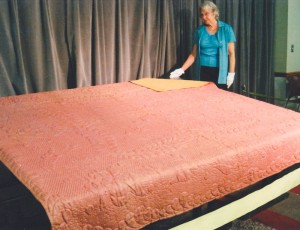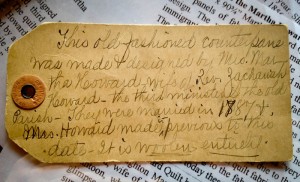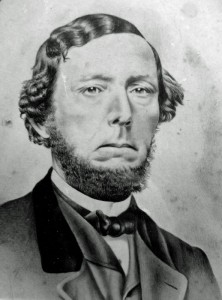True Tales: Immortal Quilt
By George T. ComeauOver 900 men and women came to Canton two weeks ago to see a rare display of one of our country’s greatest handmade treasures. This particular piece of handcraft has been a part of Canton’s history for over 225 years.

The Martha Howard Quilt in a rare public appearance and closely watched by Lorraine Hatch (Courtesy of the Canton Historical Society)
Martha Crafts was very particular, and most especially in her needlework. The second child of eight born to Dr. John Staples Crafts, Martha grew up in a well-to-do household supported by an educated family that could trace its roots back to Yorkshire, England. On a beautiful spring morning, young Martha picked up a piece of bright salmon-colored cloth and began to produce needlework that would last over two centuries.
Martha’s family settled in North Bridgewater in what is now Brockton. Born in July 1760, the Crafts were well respected in the small community. Martha’s father had been destined to be a minister after receiving an inheritance of £400 in order that he “be brought up to learning, and fitted for the ministry of the gospel.” John Crafts, however, found he was more suited for medicine, and as such he prospered in the small rural community. It is likely that Martha’s mother, Elizabeth, taught her the handiwork we see today.
Running her fingers over the tiny stitches, Martha created feathers, scallops and leaf designs. At ten stitches per inch, the work is extremely delicate and precise. The wool runs through her hands as she pulls the stiches up through the chintz-like fabric. Measuring almost seven by eight feet square, the fabric is cut from four panels of whole cloth — an extremely expensive project in the 18th century. A plain backing offsets the pink in a muted golden hue, and what Martha is creating is a piece of American history that will be adored for hundreds of years.
Today, the work that was completed by Martha Crafts (sometime between 1761 and 1787) is a superb wool quilt with provenance to suggest that it is America’s oldest surviving whole cloth quilt. And when hundreds of modern-day quilters gazed upon this work of art, the members of the Canton Historical Society were all smiles. Local historian Patricia Johnson described the quilt as being made “before the United States were the United States.” And what amazes Johnson the most is the rich symbolism and history that accompanies this common household object.
Perhaps you have a quilt that has been handed down a generation or two. Many families boast a prized and timeworn blanket that is drawn up on the coldest of New England winters. In most cases, when we think of quilts we think of patchwork pieces of cloth brought together in amazing patterns, with the patches telling stories of old suits and shirts or perhaps gingham dresses. Rarely seen, however, are whole cloth quilts. Traditionally, these quilts were made by more affluent women who had means to purchase wide bolts of fabric, which would make up the entirety of the quilt. The beauty is in the stitching that creates an elaborate design.
The history of this quilt is well recorded, and as such we know it was made prior to Martha Crafts’ marriage in 1786 to Canton’s third minister, the Harvard-trained Zachariah Howard. Born in North Bridgewater in 1758, Howard would have known the Crafts and likely attended church alongside Doctor Crafts. Howard enlisted as a soldier during the Revolutionary War, and upon his return from the Army he entered Harvard College. Graduating in 1784, within two years the young preacher was invited to become the pastor of the First Parish Church in Stoughton — in present-day Canton.

The tag that accompanied the quilt in 1910, tracing the provenance to Martha Howard (Courtesy of the Canton Historical Society)
A small card that traces the history of the quilt mentions that the quilt was made “prior to the Howard marriage in 1787.” Howard was named pastor on October 25, 1786, and within five months, with his future secure, he married Martha Crafts and brought her to live here in Canton.
The inhabitants of the First Parish were eager to see that their pastor and his wife would be made comfortable. A new roof was placed on the meetinghouse, and the building was freshly clapped. In anticipation of helping the newlyweds get settled, the parish committee advanced £187 for a piece of land and home for the Howards.
Settling down near the church, the Howards purchased a small tidy farmhouse from Theophilus Lyon in the valley just below Pleasant Street. The house that the Howards purchased was the one that David Tilden had built in 1725 on the present-day Pequitside Farm. Howard saw himself as a gentleman farmer, and after purchasing 27 acres bounded by Pequit Brook, he added another 37 acres all the way to present-day Washington Street.
The quilt came to Canton in 1787 and has been here ever since. It would seem that the Tilden House and the Martha Howard Quilt are two surviving artifacts that help tell a remarkable story about both the fledgling country and the town of Canton. Such is the case with quilts; the stories and the cloth are handed down through the generations. And while the Howards did not have any children, their generosity was well recorded.
On February 23, 1806, Zachariah Howard, “dressed in gown and bands, with his braided queue, ascended for the last time the pulpit stairs and preached all day.” According to historian D.T.V. Huntoon, as he left the church that Sunday, “he passed, bowing to the right and left, down the broad aisle to the door, the elders returning his salutation as he moved on.”
This was his last sermon, and within seven months he was gone. After 20 years, at the age of 48, “Priest” Howard passed away. He was buried in Canton Corner Cemetery, and inscribed on his headstone is a request that “gentle Seraphs bear me to the skies.”
Martha Howard would live in that house for 50 more years. As she advanced in age she befriended cats, and today if you climb the stairs in the Tilden House you can still see the small stairway that she built into the attic so they would have a place to play among the rafters of the ancient home.
At some point in the 1850s, Martha Howard supported the Gill family — who had fallen on hard times — and invited them to live with her. Having no children of her own, this kindly old lady came to love a new baby girl who was named Martha Howard Gill in her honor. The quilt was given to this child and it became a cherished part of her life after Martha Howard died in 1856 at 95 years of age.
Martha Howard Gill married into the wealthy Draper family and passed the quilt onto her son John Howard Draper. And so the quilt moved from century to century in the hands of loving people who knew what this piece of cloth meant to their families. In 1910, the Drapers gave the elaborate artifact to the Canton Historical Society.
The first thing you notice when you look at the quilt is just how tenuous it is. Cloth that is almost 300 years old is extremely fragile — time definitely takes its toll. When the Draper family donated the quilt to the local historical society, the gift was folded and placed in a wooden box framed in glass. Once framed, one whole facing portion began to fade while the inner portions remained protected from light. And that is how it was stored until it was sort of “rediscovered” in 2008.
The Canton Historical Society established the Textile Conservation Committee in 2007, and the mission was to identify all historic textiles, assess their condition and storage requirements, and develop a policy for maintaining these precious objects for generations to come. Canton resident Marie Gibbs headed up the work, and when it came to the quilt she marveled at the history in her hands. One of the first things she did was bring it to the American Textile History Museum. Once at the museum, extensive insect damage was discovered, which had caused fiber damage to the artifact. The cycle of insect damage was ongoing, from eggs to insects, all having microscopic bites of the threads of history.
In late 2008, the historical society mounted an unprecedented preservation effort — hiring Deirdre Windsor, one of the country’s foremost textile conservators, to stabilize and clean the quilt. Windsor has worked for the Museum of American Textile History, the Museum of Fine Arts, the Victoria and Albert Museum in London, and countless other private consultancies. In short, Windsor would help save the Martha Howard Quilt.
At the Blue Hills Regional School earlier this month, the quilt went on public display for two days as part of the Rhododendron Needlers Quilt Guild’s Annual Show, marking only the second time it has ever been publicly displayed. What people saw was a unique reflection upon social history and the important role of women in 18th century domestic life. To put things into perspective, the Smithsonian Quilt Exhibition holds out their oldest comparable quilt circa 1795 as the example of the earliest surviving quilts in American history. Ours is older, and the rich provenance is associated with our community to help tell the story of Martha Howard in a way that keeps her memory alive even hundreds of years after she has gone.
On Martha Crafts’ gravestone in Canton Corner Cemetery is inscribed: “This mortal hath put on immortality.” Indeed she has.
Short URL: https://www.thecantoncitizen.com/?p=19714











